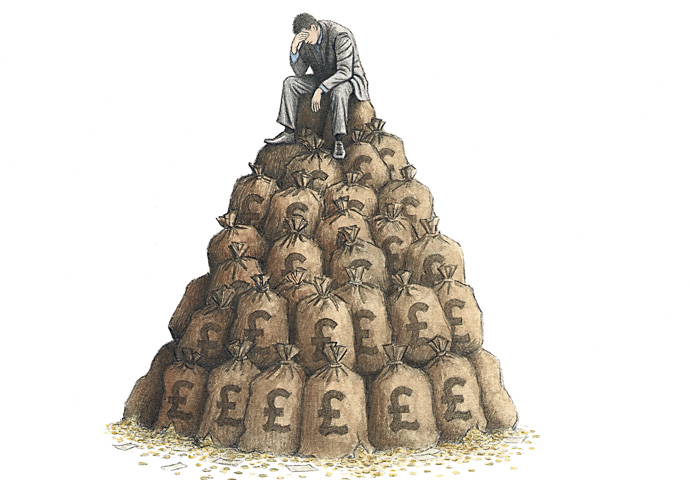Review: Serious Money: Walking Plutocratic London by Caroline Knowles
What do we know about the capital’s super-rich? Caroline Knowles’ new book attempts to provide a few answers, says Conrad Landin
Friday, 18th November 2022 — By Conrad Landin

Illustration by John Sadler. johnsadlerillustration.com
Serious Money: Walking Plutocratic London. By Caroline Knowles,
AS the cost of surviving crisis sweeps the nation, it’s tempting to think that it’s those in the most need who deserve the most sympathy.
But we should all spare a thought for Mikhail Fridman, the Ukrainian-born oligarch who bought Highgate’s Athlone House for £65million in 2016.
“It’s a kind of talent to spend money beautifully,” Fridman, whose fortune is estimated to be £12billion, once told the Financial Times. “I don’t have it.”
Even with weeks of rehearsal, most of us could never grasp the concept of spending money “beautifully” – particularly as once we’ve paid for food, shelter and – if we’re lucky – central heating – we’re unlikely to have much of it left.
Yet our bafflement proves the point Caroline Knowles wants to make: that in spite of the huge amassment of wealth in London, we know precious little about it or its hoarders.
Knowles’s remedy is walking: through the streets of Shoreditch, the City, Mayfair, St James’s, Kensington, Belgravia and Chelsea – before crossing the river to examine Richmond and Virginia Water. “Walking exposes politics, like a sediment in the landscape,” she observes.
Her strolls take her to interviewees identified only by typographical names such as “Quant” or “Cake” – to reassure her secretive interviewees and maintain her own professionalism as a sociologist. This does, however, somewhat detract from her stated aim of demystifying London’s plutocrats – though perhaps it’s also a check on humanising a class of people who often behave very strangely indeed.
Take “Legacy”, for instance, a honcho at one of London “private office” – companies that invest cash on behalf of super-rich families and trusts – who says it’s not about making money, but “the art of business”. Or the basement excavators of Kensington, who leave diggers buried underground because it’s cheaper to buy them out rather than extract them from among the townhouses.
In the narrative’s most compelling moments, walking can unravel the inner world of London’s most wealthy. We see how in Kensington, the “haves” use neighbourhood “patrols” to cast a vigilant eye on the urban behaviour of the vulgar “have yachts”. And in the Surrey enclave of Virginia Water, walking has been made all but impossible.
Yet some walks seem tangential to the narrative – such as rushed journeys between appointments that are then followed with segments of pure interview.
Others are too selective to truly capture the spirit of a neighbourhood. Knowles is, of course, fully justified in discussing how Saudi money bankrolled the London Central Mosque. But in isolation, it suggests it purely services the elite – rather than the working-class Bengali and Somali communities of south Camden too.
And given that Serious Money purports to look for solutions, it is surprising that for all her observations about the Crown Estate, Knowles limits her walk to the Nash terraces to the south of the park. If she had ventured a little east, she would have found two plots of social housing which tell a different story.
The Camden Council-owned blocks of the Regent’s Park Estate were built on land purchased from the Crown in the 1960s, at a time when local government still maintained the ambition to expand democratic accountability of housing.
The adjacent Cumberland Market, historically a Crown Estate scheme, was sold to Peabody in 2011 after a ferocious tenants’ campaign saw off the threat of full private ownership and evictions.
Both are proof that plutocratic power can be successfully challenged, and that central London still includes thriving working-class communities that exist to support each other and not just the elite.
Knowles is nonetheless right to interrogate the desire for a social “mix” voiced by numerous interviewees. In reality, she contends, this is rooted in the need for a serving class and vibrant neighbourhoods.
She skewers too the sweeping nostalgia for a time before London’s prime real estate was controlled by investment portfolios.
These “elite white histories built on racist thinking” obscure the fact that “this was always dirty money” – from the profits of imperialism and slavery.
In spite of their obscene fortunes, few of Serious Money’s subjects could be described as happy. Perhaps that’s partly because, as Knowles puts it, serious money is “actually perpetually fragile”. As the late Mark Fisher said, it is easier to imagine the end of the world than the end of capitalism. But an understanding of our current system’s grotesque excesses and its delicate basis can challenge its cultural hegemony.
Serious Money is not a manual for fighting back – but we can’t possibly produce one without this sort of serious groundwork.
• Serious Money: Walking Plutocratic London. By Caroline Knowles, Allen Lane, £25